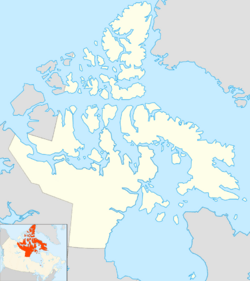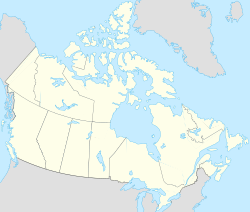Booth Island (Nunavut) facts for kids
| Geography | |
|---|---|
| Location | Hudson Bay |
| Coordinates | 59°55′N 79°56′W / 59.917°N 79.933°W |
| Archipelago | Ottawa Islands Canadian Arctic Archipelago |
| Area | 5 km2 (1.9 sq mi) |
| Coastline | 9 km (5.6 mi) |
| Administration | |
| Nunavut | Nunavut |
| Region | Qikiqtaaluk |
| Demographics | |
| Population | Uninhabited |
| Source: Booth Island at Atlas of Canada | |
Booth Island is a small, uninhabited island located in Nunavut, Canada. It is part of the Qikiqtaaluk Region, which is the largest and most northern region in Nunavut. This island is one of 24 islands that form the Ottawa Islands group.
The Ottawa Islands are found in the eastern part of Hudson Bay. This large bay is a famous body of water in Canada. Booth Island itself covers an area of about 5 square kilometers (about 2 square miles). It has a coastline of around 9 kilometers (about 5.6 miles).
Contents
Discovering Booth Island
Booth Island is a fascinating place, even though no one lives there permanently. It is a part of Canada's vast northern landscape. The island's remote location makes it a special spot in the Arctic environment.
Where is Booth Island Located?
Booth Island is situated in the huge Hudson Bay. This bay is like a giant inland sea in Canada. The island is part of a group called the Ottawa Islands. These islands are known for their rugged beauty and wildlife.
The island is located in the Qikiqtaaluk Region of Nunavut. Nunavut is Canada's largest and newest territory. It is home to many Inuit people. The Qikiqtaaluk Region covers a massive area. It includes many islands and parts of the mainland.
What Does "Uninhabited" Mean?
When we say Booth Island is "uninhabited," it means that no people live there all the time. Many islands around the world are uninhabited. They might be too small, too cold, or too remote for people to build homes.
Even though no humans live on Booth Island, it is still full of life. Many animals, like birds and marine mammals, might visit or live there. These islands are important habitats for wildlife. They provide safe places for animals to rest, feed, and raise their young.
Neighboring Islands
Booth Island is not alone in Hudson Bay. It has several island neighbors nearby. These islands are also part of the Ottawa Islands group. They share similar features and are important for the local ecosystem.
Some of the islands close to Booth Island include:
These islands together create a unique landscape in Hudson Bay. They are all part of the natural beauty of Canada's Arctic.
The Environment of Booth Island
The environment around Booth Island is typical of the Arctic region. It experiences very cold winters and cool, short summers. The waters of Hudson Bay are often covered in ice for many months of the year.
Wildlife in the Region
The area around Booth Island is home to various types of wildlife. Many seabirds nest on the cliffs and shores of these islands. They come to the Arctic to breed during the summer months.
Marine mammals, like polar bears and seals, also live in Hudson Bay. They rely on the ice and open water for hunting and travel. The islands can provide resting spots for these animals. Understanding these habitats helps us protect these amazing creatures.
Importance of Remote Islands
Remote and uninhabited islands like Booth Island are very important. They act as natural laboratories for scientists. Researchers can study wildlife and ecosystems without much human disturbance.
These islands also play a role in the global environment. They are part of the vast Arctic ecosystem. Changes in climate can affect these delicate environments. Protecting them helps maintain the balance of nature.



